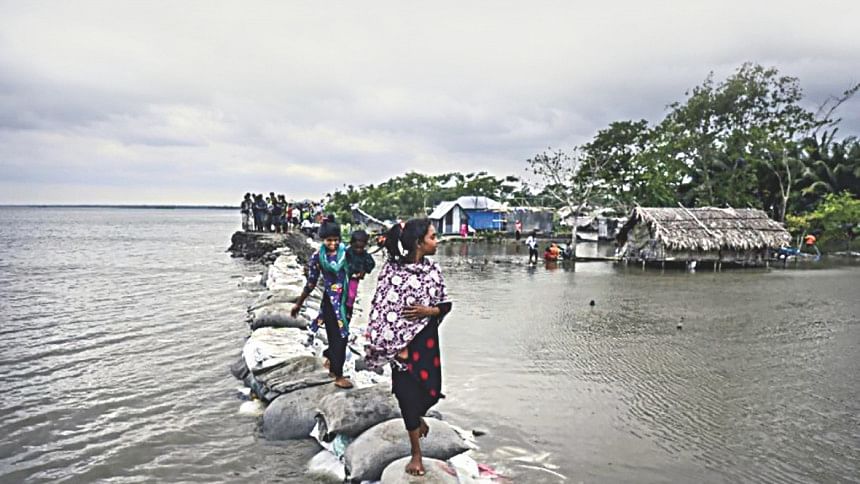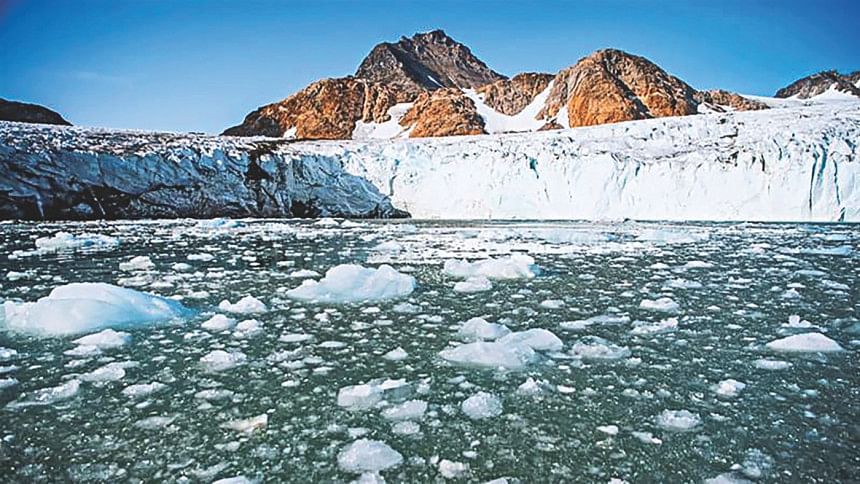Abnormals of the past are normals in the age of climate change

For millions of years, we have remained in equilibrium with our environment. In fact, a defining characteristic of the last 11,500 years, a period in Earth's history called the Holocene Epoch, has been global climate stability, with average surface temperature fluctuating plus or minus one degree Celsius. Our civilisation emerged and advanced against this backdrop of a relatively stable climate.
But then something happened that changed the face of the Earth completely for worse. Since the beginning of the Industrial Revolution in 1760, we have corrupted our planet in an unprecedented way by exerting an ever-increasing influence upon the environment. Today, we live on a planet whose air is polluted, whose water is contaminated and whose soil is chemically altered. Indeed, human influence is so substantial that Earth is no longer in the Holocene Epoch, but rather in a new geologic epoch, the Anthropocene. For comparison, the epoch before Holocene, the Pleistocene Epoch, lasted nearly 2.5 million years.
Arguably, the culprit for shattering the equilibrium of the Holocene Epoch is our unending demand for energy to fuel technological advances and sustain higher living standards. Yet until the 1970s, few of us thought much about the detrimental effects of extracting energy from fossil fuels, particularly the amount of greenhouse gases we had put into the atmosphere—more since 1990 than in all of human history before.
The current concentration of carbon dioxide, the main greenhouse gas in the atmosphere, is 415 parts per million. It is the highest since the Pliocene Epoch, which extended from about 5.3 million to 2.5 million years ago. The greenhouse gases are now acting as a delayed fuse, causing our civilisation to teeter on the brink of collapse.
In the middle is the bewildered public not knowing who or what to believe. Their bewilderment is understandable because the total climate change picture is incredibly complex. Furthermore, the bewilderment is exacerbated due to poor planning, corruption, contrivances, deceptions and business-as-usual attitude of our leaders.
We now live in a world where "abnormals" of yesteryears have become "normals" of present day. Examples of present day normals that were abnormals some 50 years ago are Bombogenesis, Arctic Amplification, Hell Fire, Pyrocumulonimbus Storms aka Fire Tornadoes, Heat Waves and Climate Refugees, Derecho, Sneaker Wave, Squall Line, Microburst, Frankenstorm, and so forth.
During winter, more often than not, a large part of northern United States is hit by an Arctic blast, sometimes severe, sometimes less severe. The blast lasts for a week or two. Thanks to climate change, in the midst of the cold spell, it is now normal for a rapidly intensifying cyclone, known as bombogenesis or bomb cyclone triggered by an extreme drop in atmospheric pressure, to dump 15-25 centimetres of snow while winds howl at 80-120 kilometres per hour.
Under normal conditions, cold air mass sits above the poles in an area called the polar vortex. It is a large, low-pressure zone that exists at two levels of the atmosphere, one in the troposphere, where most of the weather-related phenomena occur, and the other a bit higher up, in the stratosphere, home of the ozone layer that protects us from the harmful effects of ultraviolet radiation. The vortices are seasonal atmospheric phenomena.
However, scientists believe that the phenomenon of Arctic Amplification, which is the self-reinforcing process that warms the Arctic and subarctic regions much faster than rest of the world, distorts the vortex in the North Pole, thereby resulting in a sudden plunge in temperature south of the Arctic Circle. This anomaly, a consequence of global warming, was abnormal before the 1970s, but normal today.
It is no longer implausible to have record snowfall and record high temperature on the same day. On November 16 of last year, Anchorage in Alaska saw its high temperature top out at plus seven degrees at 2:30 a.m. (Average November temperature in Anchorage is negative five degrees.) Before midnight that day, 21 centimetres of snow fell on the ground. This oddity, as well as 20-25 degrees swing in daytime temperature within 24 hours in the winter months—abnormal few decades ago—are normal now.
Located a few feet below the soil surface in extremely cold regions, permafrost is one of the most unique kinds of soil containing more carbon and methane than any other soil on Earth and twice as much carbon as is available in the atmosphere. But as global temperatures rise, Arctic permafrost thaws and greenhouse gases trapped in ice are released. Clearly, permafrost thawing is opening up additional pathways for greenhouse gases, constituting a newly identified, powerful feedback to global warming. Besides, ancient carcasses are emerging from the melting permafrost, and with them germs from illness long thought eradicated.
Two years of rain in a single day was improbable even a few years ago, but it happened in Djibouti, a small East African nation, in November 2019. Rainfall from October to mid-November has risen by almost 300 percent above average in the greater Horn of Africa region, according to the Famine Early Warning Systems Network.
Nowadays, Australia and California are ground zero for out-of-control wildfires. As cataclysmic wildfires continue to rage across Australia, the loss of life—humans and animals—has reached staggering numbers. An estimated one billion animals have been killed so far and approximately 107,000 square kilometres—roughly 70 percent the size of Bangladesh—burned on the east coast.
One of the wildfires in 2018 turned the town of Paradise, located at the northwest foothills of the Sierra Nevada Mountains in California, into hell inside of two hours, making it the state's most destructive wildfire since record-keeping began. Hence the name hell fire. More than two dozen residents were burned to death—in cars, in homes and while running away on foot from the inferno. There have even been freak blazes in Lapland and elsewhere near the Arctic Circle in recent years.
The ferocious heat of wildfires generates their own weather system named pyrocumulonimbus storms or fire tornadoes, which were unheard of a few years back. Burning on a scale never seen before, wildfires and fire tornadoes are now a reality we have to live with.
Climate change is making heat waves longer and more frequent. Temperatures soaring over 50 degrees in many parts of the world are becoming the norm, while nice and comfortable weather has become the exception.

Some other wild weather phenomena due to climate change that were rare or considered abnormal in the past but not anymore are Derecho—a straight-line wind storm with hurricane-force winds; Sneaker Wave—a disproportionately large wave that suddenly appears during a wave sequence; Squall Line—a line of thunderstorms preceding a cold front; Microburst—severe downdraft caused by a thunderstorm; Frankenstorm—remnants of a super storm reinvigorated by an early winter storm and a blast of Arctic air.
Rising temperatures due to climate change is driving out oxygen from our oceans, threatening many species of aquatic life. According to the International Union of Conservation of Nature, around 700 ocean sites are now suffering from low oxygen, compared with 45 in the 1960s. Lest we forget, oceans are the source of most of the oxygen we breathe.
If the seas ever do rise by even a meter, our children and grandchildren may find themselves living cramped lives with other climate refugees on shrinking continents. "Humorously speaking," they may even try to adopt the underwater lifestyle of the cartoon character SpongeBob SquarePants, provided ocean acidification caused by absorption of carbon dioxide has not already wiped him and his pineapple home from the bottom of the rising seas.
The Amazon rainforest has existed for almost 10 million years. It might not survive the next 100 years if the Brazilian government keeps on clearing the forest for cattle ranching. Out of more than 400 species that live in the Amazon, cows now dominate the forest in terms of raw numbers. Bovine creatures grazing in the rainforest are normal sights these days.
Few years ago, the sight of polar bears roaming the streets of a village or town would have been abnormal. Nowadays, it is normal because the land on which they live and hunt is under siege. As Arctic ice thins from melting, an occurrence linked to global warming, their habitat is shrinking and food supply is decreasing. As a result, they are moving out of their natural habitat and traveling hundreds of miles south of the Arctic region in search for food.
It is now normal to hold funeral ceremony for a glacier. Last August, Icelandic officials, activists and others bade goodbye to the glacier Okjokull which died at the age of about 700. We are now looking forward to attending funeral of many more glaciers in the coming years.
The aforementioned climatological events are just a few of the normals in the age of climate change. They are a grim reminder that Mother Nature is going to do whatever science dictates, not what politicians want.
To tackle these and other new normals, every year since 1995, our leaders and/or their disciples have been meeting at various world capitals or cities, some of which are tourist hot spots―Bali, Cancun, Marrakech, Montreal, Paris―debating climate change in climate-controlled halls at the so-called Conference of Parties (COP). In order to feel what it is like living in one of the hottest places on Earth, maybe they should hold a future COP in halls without air conditioners in Jacobabad (Pakistan) during July when the average daytime temperature regularly surpasses 50 degrees.
The hype around these conferences is high, but expectations of the people are low because the proposals are not bold enough and interests of the developing countries are marginalised. Gone is the focus on establishing global "top down" approach for stabilising emissions of greenhouse gases that would be legally binding.
On the contrary, focus is on voluntary "bottom up" commitments by individual nations to reduce emissions.
It has become clear that the much-touted Paris Agreement thrashed out at COP-21 for keeping the rise in global temperature this century to two degrees above pre-industrial levels and to pursue efforts to limit the temperature increase even lower to 1.5 degrees is on life-support system. Subsequent summits, including COP-25 in Madrid two months ago, were stuck in a rut. There is no agreement yet and none is in sight.
One thus wonders whether all the hot air that is generated by all these conferences is worth the carbon cost
of all the globe-trotting participants. Accordingly, an appropriate title for these conferences should be Festival of Parties. It seems transforming conferences into festivals is a new normal of the present age.
UN Secretary-General António Guterres roped in some world leaders, members of civil societies and corporate executives at a climate summit in New York on September 23, 2019 to highlight their plans to bring down greenhouse gas emissions to zero by 2050. As expected, they "prioritised" a laundry list of Action Portfolios without any firm commitment to implement them.
The star of the summit was Greta Thunberg, the 17-year old Swedish activist, who delivered a blunt speech excoriating world leaders for their inaction. And the shameless world leaders clapped and cheered every time she chastised them with phrases like "How dare you," or "You have stolen my dreams and my childhood with your empty words." If they had any self-dignity, they should have hung their head down in shame instead of applauding. They did not do so because they are "normal" 21st century leaders.
Amid the calamitous developments resulting from climate change, there is an alarming rise during the last few years in the intentional corruption of the information system on which modern civilisation depends. In many forums, including social and electronic media, political leaders and their surrogates are lying unabashedly, insisting that their lies are truth and truth are "fake news." They distort reality, encourage social divisions, undermine trust in science, wage cyberwarfare and diminish confidence in elections and democratic institutions. Because of their behaviour, the rational discourse required for solving myriad of complex problems facing humanity aggravates many major global dangers, including those posed by climate change and nuclear weapons. Such demeanour by our leaders are now normal.
All said and done, what is the end game? Can pre-emptively embarking on a revolutionary change that will lead us away from dependency on fossil fuels and embracing eco-friendly renewable energies save our planet? Can we avoid the risk of a catastrophic failure of our increasingly ephemeral and tightly interlinked global civilisation as we know it?
The answer to the above questions is no because our leaders lack the collective will to take the decisive steps required to keep our planet liveable for the future generations. They could be described as people in gas-guzzling, carbon-emitting vehicles speeding toward a cliff deciding whether to brake, or swerve or continue straight ahead.
Scientists believe that if we started to cut down on emissions of carbon dioxide even by one percent in 1990, tackling climate change would have been manageable. Instead, waiting 30 years turned a gentle ski slope into a cruddy ski run. Also, we are unable to make use of the available renewable energy technologies to the fullest extent because of the immense political clout of the fossil-fuel industry. For them, short-term profits are more important than long-term health of our planet.
Moreover, because the inertia of the climate system is such that even if we stop introducing greenhouse gases into the atmosphere right now, the ones already in the atmosphere will keep on warming the Earth for another one to two hundred years before equilibrium is reached. In other words, climate change would keep on accelerating, regardless of what measures we take to mitigate its effects.
We can, however, partially solve the seemingly unsolvable problems we have created by changing the unsustainable lifestyle of many of us. More importantly, we have to work to address the problem of the world's ever-growing population. We are probably within a few decades of a point in time where the sheer number of people on Earth will make continuing degradation of our planet irreversible. So it is up to us whether we choose to take actions in a direction which will reduce overall global population.
The usual moral drawn from Aesop's fable of the tortoise and the hare is that steady efforts to solve problems will ultimately win out. But if we let the hare symbolise our yearning for good life and the tortoise represent steady population growth, then another moral can be drawn: despite the slow pace of the tortoise there is a point beyond which the late-starting hare cannot possibly catch up, no matter how hard and fast he runs.
Finally, our generation has one foot already in the grave and another on a slippery slope. So, more likely than not, we will miss the worst of climate change and will not witness the permanent and lasting damage done to Earth by us. My concerns, however, are more than just despair over our failures, but expressions of anguish for our children. By 2050, my son and daughter will be in their fifties. If prediction of three degrees rise in global temperature proves accurate, no matter what humans are able to do over the coming years, they will be living in a radically transformed world—a veritable furnace. Apocalypse will then be the new normal.
Quamrul Haider is a Professor of Physics at Fordham University, New York.

 For all latest news, follow The Daily Star's Google News channel.
For all latest news, follow The Daily Star's Google News channel. 



Comments